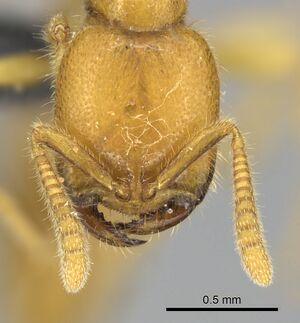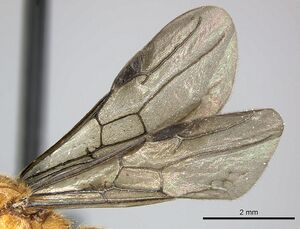Adetomyrma bressleri
| Adetomyrma bressleri | |
|---|---|

| |
| Scientific classification | |
| Kingdom: | Animalia |
| Phylum: | Arthropoda |
| Class: | Insecta |
| Order: | Hymenoptera |
| Family: | Formicidae |
| Subfamily: | Amblyoponinae |
| Tribe: | Amblyoponini |
| Genus: | Adetomyrma |
| Species: | A. bressleri |
| Binomial name | |
| Adetomyrma bressleri Yoshimura & Fisher, 2012 | |
The males of A. bressleri (= mg03: Yoshimura & Fisher 2012) have been collected numerous times by Malaise traps at the higher elevations of Montagne d'Ambre (900–1300m). The first collection date from Malaise traps was in 2001. Since then, three expeditions to Montagne d'Ambre have been organized to find the female castes, but not until 2011 was the worker caste finally found. To find the worker caste, Malaise traps were set up and monitored for the collection of males. Once males were collected, logs and branches on the ground around the trap were inspected. On the last day of the trip in 2011, workers were found in a log near a trap that had collected males. As the log was pulled apart for worker ants (BLF26111), the nearby Malaise trap (BLF26044), which was moved directly above the log, captured males leaving the log. These collections did not yield a visible queen but included 291 workers and 814 larvae. (Yoshimura & Fisher 2012)
Identification
Yoshimura & Fisher (2012) - Workers of Adetomyrma bressleri are clearly distinguished from other genus members by a combination of a single shorter hair lateral to the longest one on the anterior clypeal margin in full-face view, the presence of a small denticle on the basal portion of the mandibular subapical tooth, and a large propodeal spiracle that is located posterodorsally and fully visible in dorsal view. A. bressleri is easily distinguished from other Adetomyrma males by its giant yellow body, parameres overlapping broadly on almost the whole length of the basimere, and a flattened, needle-like projection on the posterodorsal portion of the paramere.
Keys including this Species
Distribution
Latitudinal Distribution Pattern
Latitudinal Range: -12.27138889° to -19.006727°.
| North Temperate |
North Subtropical |
Tropical | South Subtropical |
South Temperate |
- Source: AntMaps
Distribution based on Regional Taxon Lists
Malagasy Region: Madagascar (type locality).
Distribution based on AntMaps
Distribution based on AntWeb specimens
Check data from AntWeb
Countries Occupied
| Number of countries occupied by this species based on AntWiki Regional Taxon Lists. In general, fewer countries occupied indicates a narrower range, while more countries indicates a more widespread species. |

|
Estimated Abundance
| Relative abundance based on number of AntMaps records per species (this species within the purple bar). Fewer records (to the left) indicates a less abundant/encountered species while more records (to the right) indicates more abundant/encountered species. |

|
Biology
Castes
Worker
Images from AntWeb
     
| |
| Holotype of Adetomyrma bressleri. Worker. Specimen code casent0205995. Photographer Ryan Perry, uploaded by California Academy of Sciences. | Owned by CAS, San Francisco, CA, USA. |
    
| |
| Paratype of Adetomyrma bressleri. Worker. Specimen code casent0205996. Photographer Ryan Perry, uploaded by California Academy of Sciences. | Owned by NHMUK, London, UK. |
    
| |
| Paratype of Adetomyrma bressleri. Worker. Specimen code casent0205997. Photographer Ryan Perry, uploaded by California Academy of Sciences. | Owned by MHNG, Geneva, Switzerland. |
   
| |
| Paratype of Adetomyrma bressleri. Worker. Specimen code casent0205998. Photographer Ryan Perry, uploaded by California Academy of Sciences. | Owned by CAS, San Francisco, CA, USA. |
    
| |
| Paratype of Adetomyrma bressleri. Worker. Specimen code casent0205999. Photographer Ryan Perry, uploaded by California Academy of Sciences. | Owned by NHMB, Basel, Switzerland. |
Male
Images from AntWeb
     
| |
| Male (alate). Specimen code casent0007350. Photographer April Nobile, uploaded by California Academy of Sciences. | Owned by CAS, San Francisco, CA, USA. |
     
| |
| Male (alate). Specimen code casent0008693. Photographer April Nobile, uploaded by California Academy of Sciences. | Owned by CAS, San Francisco, CA, USA. |
      
| |
| Paratype of Adetomyrma bressleri. Male (alate). Specimen code casent0205990. Photographer Ryan Perry, uploaded by California Academy of Sciences. | Owned by CAS, San Francisco, CA, USA. |
Nomenclature
The following information is derived from Barry Bolton's Online Catalogue of the Ants of the World.
- bressleri. Adetomyrma bressleri Yoshimura & Fisher, 2012b: 12, figs. 7, 9, 13, 30, 39, 48, 57, 65, 73, 74, 81 (w.m.) MADAGASCAR.
- Type-material: holotype worker, 4 paratype workers, 1 paratype male.
- Type-locality: holotype Madagascar: Antsiranana, Parc Nat. Montagne d’Ambre, 12°30.83’S, 49°10.67’E, 984 m., 2.iii.2011, BLF26111, montane rainforest, ground nest (B.L. Fisher, et al.); paratypes: 4 workers with same data, 1 male with same data but 23-24.ii.2011, BLF26044.
- Type-depositories: CASC (holotype); BMNH, CASC, MCZC, MHNG (paratypes).
- Distribution: Madagascar.
Unless otherwise noted the text for the remainder of this section is reported from the publication that includes the original description.
Description
Worker
Measurements: holotype. HL 0.85, HW 0.8, SL 0.45, HD 0.5, WL 1.03, PnW 0.46, MnW 0.25, PpW 0.41, PtW 0.38, CI 93.6, SI 56.9, MnI 31.8, PpI 159.8, PtI 94.1. HL 0.84–0.9, HW 0.73–0.8, SL 0.46–0.48, HD 0.48–0.55, WL 0.98–1.08, PnW 0.45–0.48, MnW 0.24–0.27, PpW 0.38–0.43, PtW 0.37–0.41, CI 86.7–89.5, SI 59.7–63.2, MnI 30.7–34, PpI 152.8–168.8, PtI 93.1–97.7 (4 paratypes measured).
Head subquadrate in full-face view: longer than wide, sides slightly convex, wider around midlength of head capsule, weakly converging anteriorly and posteriorly, posterior margin concave. Clypeal principal surface deflected ventrally. Anterior margin of clypeus broadly convex, furnished with row of about 26 small, specialized, conical setae. Frontal carinae in full-face view short and low, expanded laterally as small frontal lobes about 1.5× wider than length of antennal insertions. Mandible subfalcate, without distinct basal and masticatory margins, inner margin with two apical teeth and five basal denticles: one small denticle on base of subapical tooth (second tooth from apex); out of five denticles, second and fifth denticles from apical-most one larger than others; second denticle largest (longest); third denticle small and adjacent with second one, and division between them unclear on its base; basal-most denticle sometimes divided into two adjacent small, low denticles (observed in CASENT0205999). Palpal formula 3,3 (three maxillary and three labial). Antennal scape shorter than head length. Pedicel (second antennal segment) shorter than combined length of next three (third to fifth) antennal segments. Antenna gradually broadened from third segment and not forming distinct club. Dorsal outline of mesosoma in lateral view somewhat arched, mesonotum raised from pronotal and propodeal dorsum, metanotal groove often clearly impressed. Pronotum in dorsal view longer than broad, with convex sides. Mesonotum in dorsal view short, slightly wider than long. Metapleuron fully fused with propodeum, but divided by shallow furrow. Dorsal face of propodeum almost as wide as pronotum, less than 1.5× longer than wide, sides strongly converging toward mesonotum. Propodeal dorsal margin in lateral view less than 2× the length of the declivitous margin, rounding gently into the latter. Propodeal spiracle large, located close to propodeal dorsal margin in lateral view, fully visible in dorsal view. Subpetiolar process distinctly developed, shaped like an irregular axe blade. Shallow and sparse punctures covering head, mesosoma, and abdomen. Clypeus with two groups of hairs; mid clypeal hairs directed dorsally, and anterior clypeal hairs deflected anteriorly. Mid clypeal hairs consisting of one long hair and one or two shorter hairs around the long one. With clypeus in full-face view, anterior clypeal hairs consisting of one pair of long hairs and a single shorter hair laterally.
Male
Measurements: HL 0.82–0.86, HW 1.18–1.26, SL 0.27–0.3, EL 0.44–0.51, WL 2.22–2.35, MnW 1.55–1.69, CI 140.4–147.2, SI 22.9–24.4, EI 54.1–59.3, MnI 129.3–140.6 (5 individuals measured).
Eye well-developed and prominent, posterior margin not exceeding posterior margin of mid ocellus in full-face view. Distance between lateral ocellus and eye long, 3× longer than diameter of lateral ocellus. Palpal formula 3,3 (three maxillary and three labial). Notaulus absent on mesoscutum. Parapsidal line clearly impressed. Anterior margin of petiole longer than dorsal margin in lateral view. Subpetiolar process well-developed, with dense hairs ventrally.
Left and right parameres broadly overlapping along almost entire length of basimere. Distinct, flattened, and needle-like projection present on each posterodorsal portion of paramere. Basal ring reduced to about 0.33× of parameral maximum height in lateral view. Basal projection on cuspis extraordinarily well developed, as large as digitus, and replacing the usual position of cuspis; cuspis also well developed and elongate, and surrounding digitus. Aedeagus in lateral view; mid portion distinctly widened and distal portion extremely narrowed; ventral projection vestigial and inconspicuous; its apical portion narrowed but hard, and curved as a hook.
Hair on compound eyes long, almost as long as diameter of mid ocellus. Mesofemur in dorsal view with anterior face covered in dense subdecumbent hairs. Ventral margin of eye edged with darker pigment but without minute punctures on the area. Body yellow with bicolored head, brown on its dorsal face and yellow on its ventral face.
Type Material
Holotype. Worker: CASENT0205995, BLF26111: MADAGASCAR, Antsiranana, Parc National Montagne d'Ambre, 12° 30.83´ S, 49° 10.67´ E, 984 m alt., montane rainforest, ground nest, 2.iii.2011, B.L.Fisher et al. leg. California Academy of Sciences
Paratypes. 4 workers: CASENT0205996 The Natural History Museum, CASENT0205997 Musee d'Histoire Naturelle Genève, CASENT0205998 Museum of Comparative Zoology, CASENT0205999 Naturhistorisches Museum, Basel, with same data as holotype; 1 male, CASENT0205990, BLF26044: MADAGASCAR, Antsiranana, Parc National Montagne d'Ambre, 12° 30.83´ S, 49° 10.67´ E, 984 m alt., montane rainforest, Malaise trap, 23–24.ii.2011, B.L. Fisher et al. leg. [CASC]
Etymology
The specific epithet is a patronymic referring to Dr. Barry Lee Bressler, retired physicist, former adjunct professor of physics at Virginia Polytechnic Institute and State University, and amateur naturalist, in recognition of his interest in myrmecology and his support for research on ants. The species epithet is treated as a noun in apposition, and thus invariant.
Determination Clarifications
This new species corresponds to the following species code below used in previous studies: mg03
References
- Cantone S. 2017. Winged Ants, The Male, Dichotomous key to genera of winged male ants in the World, Behavioral ecology of mating flight (self-published).
- Yoshimura, M. & Fisher, B.L. 2012b. A revision of the Malagasy endemic genus Adetomyrma. Zootaxa 3341: 1-31.
References based on Global Ant Biodiversity Informatics
- Yoshimura M., B.L. Fisher. 2012. A revision of the Malagasy endemic genus Adetomyrma (Hymenoptera: Formicidae: Amblyoponinae). Zootaxa 3341: 1-31.




